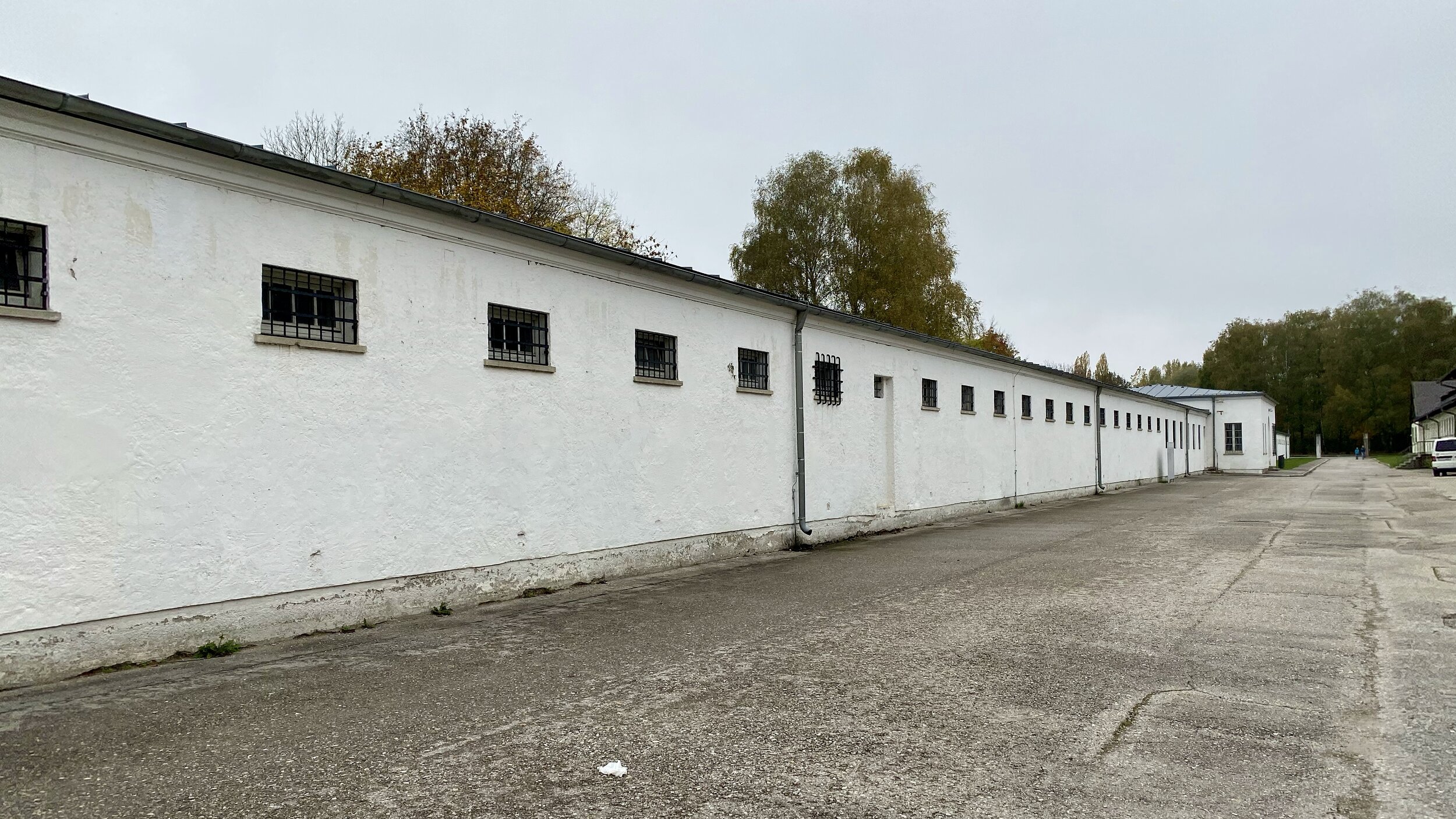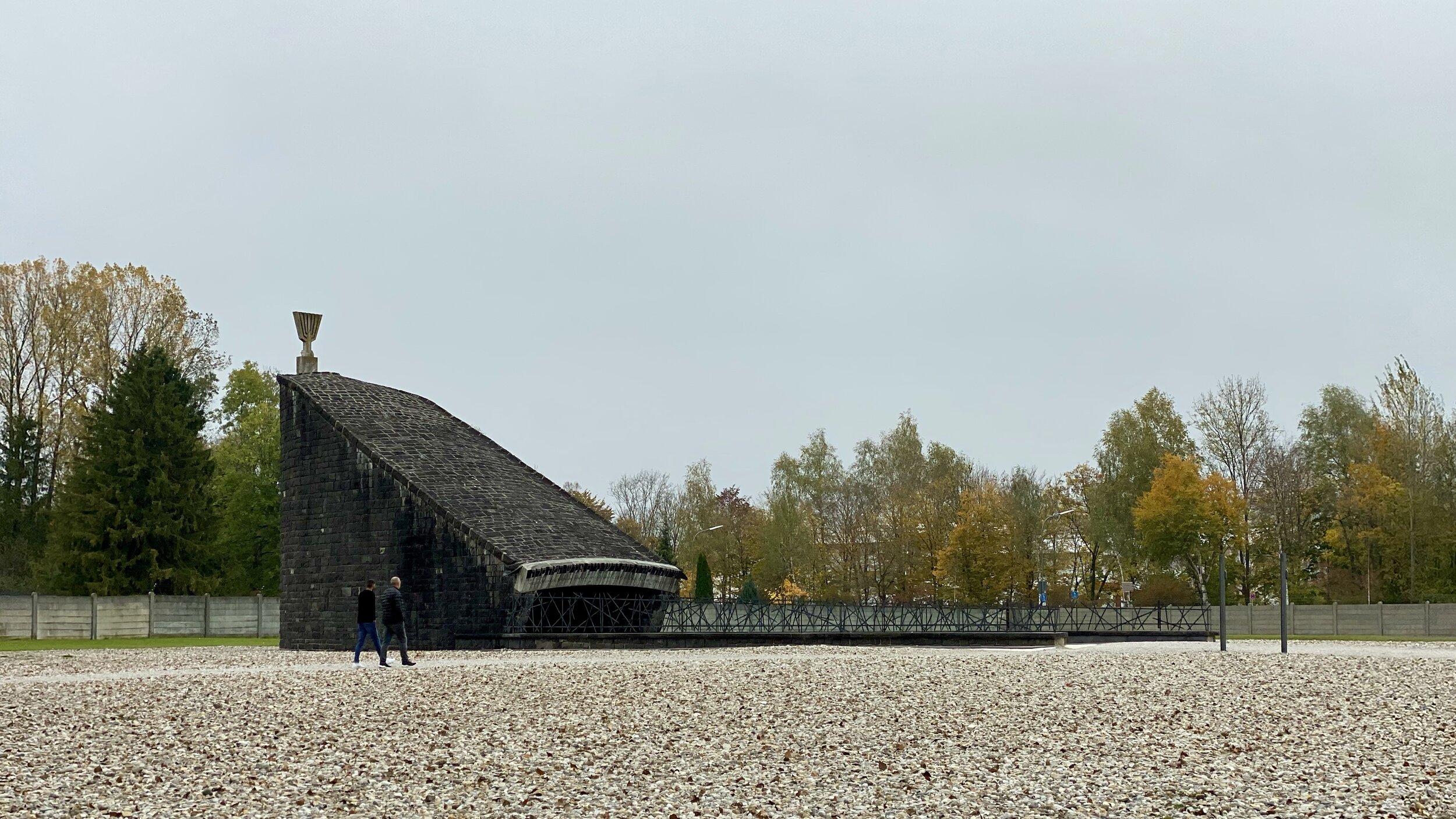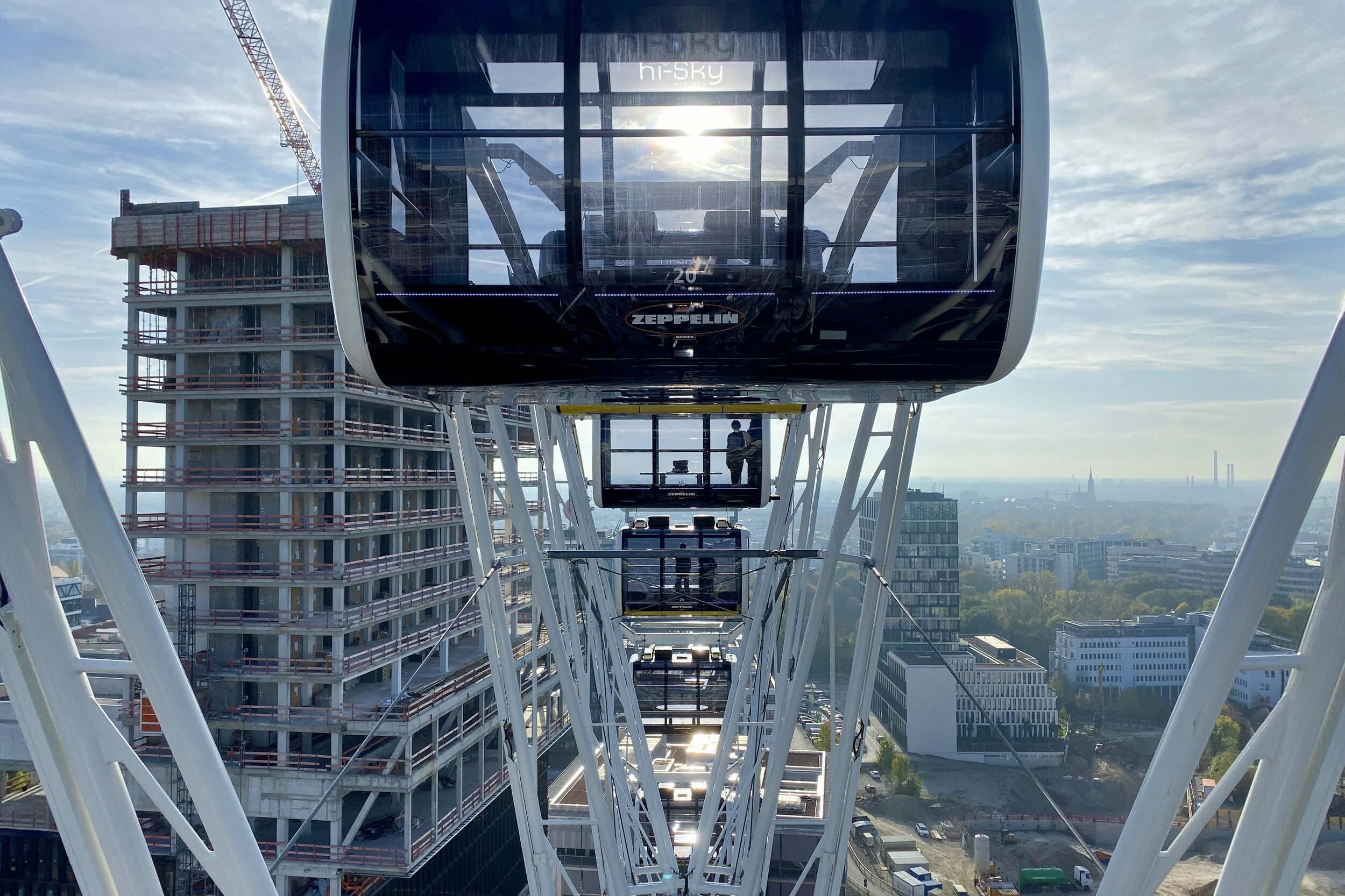Munich, 23 Oct 2019
On our last full day in Munich, we went out to visit the Dachau Concentration Camp Memorial Site. We then headed out to Werksviertel district to ride a Ferris wheel, hang out in a cafe, and go to a concert.
The morning was our usual routine. We headed to the S-Bahn and headed out of the city center to Dachau. It was easy to find the bus we needed, both because of the sign and the small group of people waiting at the stop. A couple of tour groups showed up soon after, and then the bus pulled up. After we all got on, the bus waited some more, probably for another train, then the packed bus drove to the Dachau memorial site.
Dachau
We all piled out and then started walking. The visitor parking lot is being completely redone, so the buses don't go right to the site now, which meant walking a couple of blocks. There were pretty good temporary signs put up, but even if they weren't, we could have just followed the other groups of people. Once at the information center, we picked up a map and then worked our way to the museum.
Walls encompass the museum, a bunker, a couple of barracks, and some memorials, but the vast majority is left open. The majority of the open area is taken by foundations of where most of the barracks used to be. Between them and the museum is a large, open space that used to be the assembly area where roll calls were done; part of that area is now taken by an international monument.
While Auschwitz is said to be more chilling, with far more people killed at larger Auschwitz. Even so, Dachau is still sobering; there were still many deaths, and humanity was still stripped from the prisoners. And those weren't the only two camps. There was a whole system of them throughout Germany and the land it conquered.
While there are artifacts scattered among the rooms of the museum, the stories and rooms are left to speak for themselves. The museum is located in the former maintenance building, but it's also the building where incoming prisoners were processed, and some punishments were carried out there, too.
Next to the museum is a bunker, which was a former cellblock for “special prisoners”, such as German religious leaders and people who tried to assassinate Hitler. On the other side are the where pairs of barracks were, with a couple of them reconstructed. Towards the end of the war, there were 30,000 prisoners in those 34 barracks, each measuring 10 by 100 yards.
Between the rows of barrack foundations is a tree-lined path leading to the Catholic Mortal Agony of Christ Chapel, the Jewish Memorial, the Protestant Church of Reconciliation, the Carmelite Convent, and the Russian Orthodox Chapel.
Past the memorials is the crematorium, which is actually used to burn the bodies of dead prisoners. There is a gas chamber in the newer, larger crematorium, originally disguised as a shower room. It wasn't used for mass murder at Dachau, but it was used a few times for “experiments”.
On the way back to the hostel, we noticed the sky was starting to clear. We had dismissed going up St. Peter's tower because it was quite overcast. Likewise, we saw there was a Ferris wheel, but figured there wouldn't be much of a view. Since there was a lot of blue by the time we got out of the S-Bahn station, we were considering doing the Ferris wheel since it would be near where we were going to a concert.
Werksviertel
We had already purchased a multi-person, all-day pass which let us go outside the central Munich area to go to Dachau, and it would come in handy as we headed on the U-Bahn to Ostbahnhof. It took us a few tries to get north of the Deutschebahn tracks, but we finally found a way. A few blocks later, we had arrived at Werksviertel, a new development that seems to be trying to make a very dense area where people can work, live, and enjoy the arts. There are several buildings named starting with Werk 1, which happens to be a place to incubate businesses. It has both flexible offices and co-working space, as well as access to mentors.
Our first order of business was to ride the Ferris wheel. There weren't many people riding, so we had a 16-person car all to ourselves. As we started going up, we got a look at the green roof on top of Werk 3 which has not only gardens but also has sheep. As we got higher, we saw the Munich old town (Frauenkirche's twin domes were easy to pick out) as well as the city stretching out in all directions. The ride lasted about a half-hour, so we had plenty of time to take in the view.
Being above Werksviertel made it possible to take a look at the layout and what paths were open since construction blocked off several possible routes. Taking advantage of that, we sought out the Technikum, so we would know where the evening’s concert would be. We found the right building, Werk 7, but needed to go further around the building to finally find it. We had quite a bit of time before the doors opened, so we went to the Werk 1 Café, where there was supposed to be good wireless (since the building has a co-working space). We got our drinks and wifi access codes good for two devices each, but only my laptop was able to keep a consistent connection the whole time we were there. What’s funny is the best internet connection I’ve had so far this whole trip was in the Viktualienmarkt where I happened across an eduroam connection, the consortium that UW is a part of. The connection was very fast, so I ended up being able to upload a lot of photos from my phone. Go figure.
When we were done at the café, we sought out dinner. Having scooped our options earlier, we went to a Thai restaurant and had duck Pad Thai which was quite good. Since it was still a bit early, we wandered around Werksviertel Mitte, a section made up of repurposed shipping containers. We also saw a sign for gelato, which meant a mandatory stop. The cups we got edible, made of the same material as a wafer cone.
Back to the Technikum to find seats for the concert. People were milling around in the lobby getting wine, but we found seats and settled in. The venue was a pretty industrial place but painted and lit to be pretty hip. There was a section on the side with small tables where people could sit and a balcony which acted as a green room. Instead of the orchestra members wandering onto the stage, they warmed up in the balcony and only when the concert was to begin did they all go to the stage.
The program was supposed to be short, consisting of short pieces interspersed with commentary by lecturer Prof. Stefan Klein and a moderator. Of course, they were speaking German, and rather quickly, so I caught a few words and there were some I had to think more about (by which time they were several sentences further along). Melody did quite a bit better, of course.
The theme of the evening was “Time Machine”, but not in the science fiction sense. They discussed strict vs. flexible tempo as well as perceived vs. actual time. At one point Klein talked about Hitchcock’s money Rope and how the suspense changes perceived time.
The orchestra was a bit inconsistent. Some pieces sounded great, and others seemed like they could have used a bit more time to pull together. There was one piece from a composer neither of us had heard of which was really interesting and the orchestra nailed. There was another where the concertmaster did a quiet drone tone which gave the piece a really eerie tone.
It seems that, even though the announcement fit the event said it would be about an hour, there was an hour of music and about 40 minutes of commentary. This was the first event of this type so they’re still tuning the formula.
At the end of the concert, there was long, thunderous applause, but everyone remained seated. It actually felt appropriate, just as it feels odd that every performance in Seattle gets a standing ovation.
After the concert, we started heading back to the U-Bahn station and saw the elusive stairway down to the train station we missed earlier in the day. That let us go directly under the tracks, cross the street, and then go down to our train. Good to know, I guess, but it’s not as if we’ll need the information.
That was it for our stay in Munich. Tomorrow, it’s off to Berlin.
























